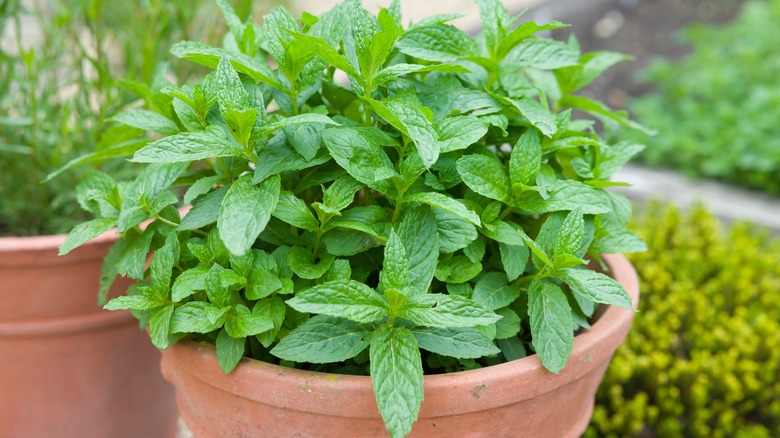The Best Place To Plant Mint, According To Martha Stewart
The sweet scent of mint will make you want to plant it all over your garden, but you may want to rethink that before you do. Mint is an invasive herb that spreads rapidly and will quickly overtake everything around it and then some. It's also incredibly hardy and can survive bitter cold temperatures, making it a trustworthy perennial plant that will come back each year. Its fast growth and determination can be appreciated if you want a lot of mint, but you won't like it so much if it hinders your other plants. However, there's one way you can make sure mint won't leave you with a headache, as suggested by Martha Stewart: grow it in a container.
Containing this minty beast is necessary to maintain a functioning garden. Pruning mint can be tough to stay on top of since it grows so much, and the underground runners like to hide. But if you keep it contained in a pot, you won't have to worry about it growing wherever it wants. Here's why.
Keep your mint secluded in a pot
Mint can't assert its dominance over other plants if it's not even part of the garden. Martha Stewart had the brilliant idea to plant mint in a pot. Doing so will allow you to keep it on its own while benefitting from a constant harvest all summer long. It won't be able to spread out of control, but pruning it will encourage it to keep growing. "Mint in a container: it's a good thing," she shared on her official TikTok.
An alternate method is putting the pot in the ground with the rest of your garden. Make sure the pot has a drainage hole and is at least five inches tall. Since mint's roots grow shallow, a 5-inch pot is big enough to contain it. When burying it, ensure only an inch or so of the pot is above the soil line. Plant mint in the planter just as you would above ground.
Mint spreads with underground rhizomes that develop new stems that pop up. If the in-ground container is deep enough, the rhizomes won't be able to escape, and it won't grow out of control. However, it will need to be repotted when the roots reach the bottom of the container. You'll know it's time when you notice yellowing leaves for no reason, hinting it doesn't have enough room to flourish. Repot it in early spring so it can have the entire summer to settle in its new soil, allowing it to survive the winter.
